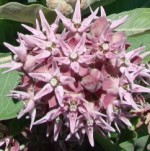 Showy milkweed is a herbaceous perennial native to Northwest and north central US where it can be found in sunny moist to dry sites including savannas, prairies, roadsides, abandon fields, and meadows. It is a member of the dogbane family, Apocynaceae, that also includes bluestar (Amsonia), periwinkle (Vinca), and oleander (Nerium). Growing from a tap root, the erect stems are sparingly branched and covered with short, soft hairs. The oval leaves are blue-green, woolly, and four to eight inches long. The flowers are pale to purplish pink and are carried in tight umbels on stalks in the leaf axils and at the top of the stems from late spring through summer. Each flower has a reflexed corolla surrounding a star shaped structure that consists of five hoods with hooks and the fused sexual parts of the plant. The flowers give way to large attractive pods that contain flat oval seeds each with long silky hairs that facilitate wind dissemination. The milky sap of the plant is toxic but less so than that of most other milkweed species. The flowers are a good source of nectar for hummingbirds and many insects including bees and butterflies, and the foliage is the larval food of the monarch butterfly.
Showy milkweed is a herbaceous perennial native to Northwest and north central US where it can be found in sunny moist to dry sites including savannas, prairies, roadsides, abandon fields, and meadows. It is a member of the dogbane family, Apocynaceae, that also includes bluestar (Amsonia), periwinkle (Vinca), and oleander (Nerium). Growing from a tap root, the erect stems are sparingly branched and covered with short, soft hairs. The oval leaves are blue-green, woolly, and four to eight inches long. The flowers are pale to purplish pink and are carried in tight umbels on stalks in the leaf axils and at the top of the stems from late spring through summer. Each flower has a reflexed corolla surrounding a star shaped structure that consists of five hoods with hooks and the fused sexual parts of the plant. The flowers give way to large attractive pods that contain flat oval seeds each with long silky hairs that facilitate wind dissemination. The milky sap of the plant is toxic but less so than that of most other milkweed species. The flowers are a good source of nectar for hummingbirds and many insects including bees and butterflies, and the foliage is the larval food of the monarch butterfly.
Type: Herbaceous perennial
Bloom: Tight umbels of pale to purplish pink in leaf axils or tip of stem from late spring through summer
Size: 2-4’ H x 1.5-3’ W
Light: Full sun
Soil: Average, medium moist, very well-drained
Hardiness: Zones 3-8
Care: Low maintenance
Pests and Diseases: Aphids; root rot can be a problem in poorly drained soil.
Propagation: Seed (spring sown seed profits from moist stratification), root cutting in fall or early spring
Companion Plants: Blanket flower (Gaillardia aristata), ‘East Friesland’ sage, silver leaved artemesias, butterfly bush, Liatris